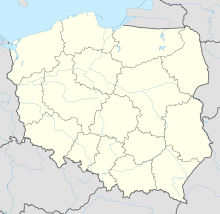Wollin Castle
Coordinates: 53 ° 50 '40.8 " N , 14 ° 36" 58.8 " E

The Wolin Castle was a castle of the Dukes of Pomerania on the now Polish island of Wolin in the same city .
Bishop Otto von Bamberg was already accommodated in a fortified princely house in Wollin on one of his mission trips through Pomerania. Castellans managed the wooden building and the Wollin castle district until the 13th century, when the house was the seat of the Mecklenburg prince Pribislaw I and, after his death, his son Pribislaw II. Later ducal bailiffs took over the administration. In 1284 the castrum Wolyn was mentioned in a document.
During the existence of the Duchy of Pomerania , the stone building rebuilt repeatedly served as the widow's seat of the Pomeranian duchesses or as a residence for non-ruling members of the Greifenhaus , such as Barnim IX. in his younger years. Otherwise, a governor lived in the main building of a complex that included stables, a granary, a brewery and the renting shop .
Philipp Hainhofer , who accompanied Duke Philipp II on a long journey in 1617, left a description of the castle in his travel diary. After that, the old building, in which the Duchess Anna Maria von Brandenburg had her widow's residence from 1603 to 1618 , only offered accommodation for ten people from the ducal court. According to Hainhofer's information, there were portraits of princes in the large hall. At about the same time, Wollin's vedute was drawn, which can be found on the edge of the Lubin map . This shows on the right edge a building with a rectangular floor plan, decorated with a stepped gable and a pointed copper-covered roof turret with a clock. In 1620 the condition of the castle, which was to serve as residence for Sophie von Sachsen (1587–1635) , the widow of Duke Franz , was so bad that it was demolished and replaced by a new building on the same site. Some outbuildings were damaged in the great fire in 1628. During the inventory carried out in 1636 after the death of Duchess Sophie, an unfinished interior of the brick building was found. The neighboring former monastery church was used as a granary.
After the griffin dukes died out during the Thirty Years' War , the palace came into the possession of the Swedish governor Johan Banér (1596–1641), whose heirs ceded it to the Swedish queen widow Maria Eleonora in 1648. From her daughter Queen Christina , in 1654 Clas Graf Tott (1630–1674) acquired the palace and office of Wollin and pledged it in 1655 - the legality was confirmed in 1657 - to Christoph Carl Graf Schlippenbach (1624–1660). Already badly damaged by imperial and Brandenburg troops during the siege and storming of Wolin in 1659 in the Second Swedish-Polish War , the castle burned down when it was conquered by the Brandenburgers in the Swedish-Brandenburg War in 1675 and was never rebuilt.
literature
- Hugo Lemcke (Ed.): The architectural and art monuments of the administrative district of Stettin. Booklet IV: The district of Usedom-Wollin. Saunier, Stettin 1900, p. 418f.
- Georg Wilhelm von Raumer: The island of Wollin u. the seaside resort of Miedzyzdroje. Decker, Berlin 1851, p. 151ff.
Individual evidence
- ^ Pomeranian document book . (PUB) II, No. 536.
